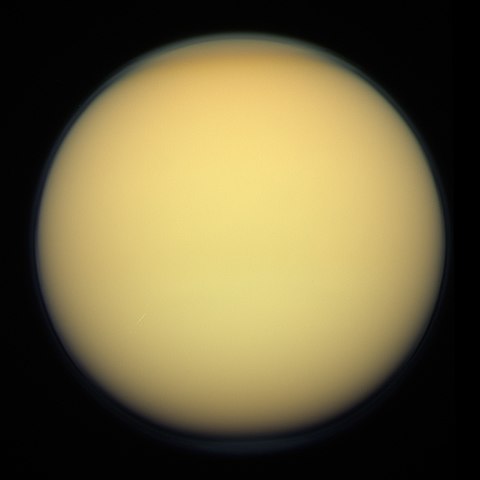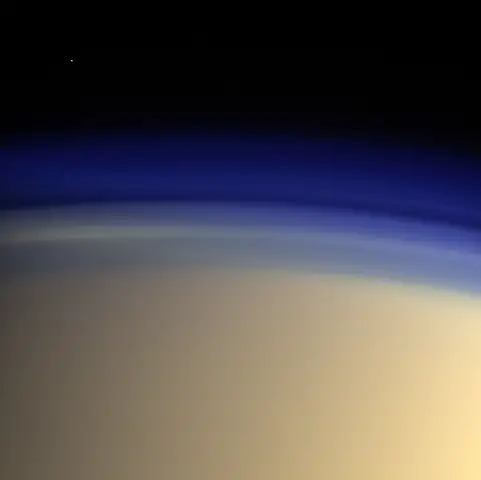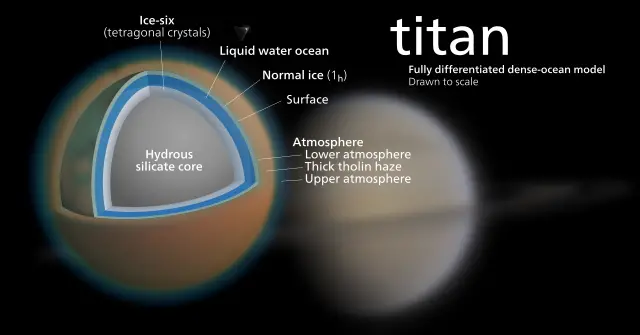Saturn’s largest moon Titan is an object of intense fascination for astronomers and scientists alike. Its mysterious atmosphere, distinctive surface features, and potential for life all contribute to its appeal.
Despite being the second largest moon in the Solar System, very little is known about the enigmatic Titan.
Introduction
Its unique features and characteristics separate it from its counterparts, making it a fascinating subject of exploration. Its atmosphere is the only one of its kind in the Solar System, composed of mostly nitrogen and methane. The composition of its surface is unlike any other moon, with features such as lakes and rivers which have been found to contain liquid ethane and methane.
The increasing interest in the Saturnian moon has spawned several exploration missions. Several probes have been sent to study the moon and its atmosphere, providing invaluable data for scientists to analyze. Data from these exploratory missions has provided us with a better understanding of Titan and its environment.

The potential for life on Titan has been a topic of discussion amongst astronomers and astrobiologists. Its environment contains several key components of life, such as a viable atmosphere, organic compounds, and liquid bodies. Theories have been proposed which suggest the possibility of microbial life existing on Titan.
The complexity of Titan is astounding, and its secrets remain largely unsolved. With the data from exploratory missions and the ongoing discussion on the potential for life, our understanding of the Saturnian moon is constantly expanding. In the following sections, we will take a closer look at the structure and composition of Titan, its unique atmosphere, and its surface features. We will also discuss the exploratory missions conducted on the moon and the potential for life on Titan.
Composition and Structure
Since the time it was first discovered, the composition and structure of Titan has been an area of great interest to scientists. This is mainly because of its size and location, making it the only moon in our solar system that has a thick atmosphere. NASA’s Cassini mission has helped to uncover the secrets of Titan’s structure, which is unlike any other moon.
At its core, Titan is composed of a rocky core surrounded by a layer of water ice. Above this is a thick layer of solid nitrogen, which is thought to be several kilometers thick. In addition, there is a layer of organic compounds, including methane, ethane, and propane. This layer is thought to be between 100 to 150 kilometers thick.
The unique composition and structure of Titan is quite different from that of other moons in our solar system. For instance, Titan’s atmosphere is much thicker and more complex than that of Earth’s moon. It is believed that Titan’s atmosphere is composed of nitrogen, oxygen, carbon dioxide, methane, ethane, and propane.
The lower level of Titan’s atmosphere is much warmer than the upper level, and it is believed to be the cause of both the hydrocarbon clouds and the hazy atmosphere. In addition, the atmosphere of Titan is much denser than that of Earth, and its gravity is about one-seventh that of Earth.
In terms of structure, Titan is believed to have a rocky crust, which is surrounded by an icy mantle. Beneath this is thought to be a layer of liquid water, which may be several kilometers thick. It is thought that this layer may contain nitrogen and organic compounds, and it is believed that this layer may be the source of the hydrocarbon clouds.
The unusual composition and structure of Titan has allowed scientists to gain more insight into the formation of other moons and planets in our solar system. The Cassini mission has allowed us to understand much more about the unique environment of Titan and its potential for life. This has also helped us to gain a greater understanding of the formation of other moons and planets, as well as the potential for life beyond our own planet.
Atmosphere
Titan is the only moon in the solar system known to possess its own atmosphere. The atmosphere of Titan is primarily composed of nitrogen and methane, with traces of other gases such as ethane and hydrogen. It is very similar to the Earth’s atmosphere in composition but differs in pressure and temperature. It is much denser and colder than Earth’s atmosphere. The atmospheric pressure on Titan is about 1.5 times greater than that on Earth at sea level, and the temperature is about minus 179 degrees Celsius.
Titan has a unique atmosphere due to its distance from the Sun and the lack of energy it receives. The atmosphere of Titan is opaque to visible light, making it difficult for telescopes and other instruments on Earth to observe and study. However, Titan’s atmosphere does allow the passage of infrared light, which has enabled scientists to study its composition.
The atmosphere of Titan is also known for its complex chemistry, which is driven by the ultra-violet radiation of the Sun. This chemistry drives the formation of aerosols and hydrocarbons, which are believed to be the building blocks of Titan’s complex organic chemistry. These hydrocarbons and aerosols contribute to Titan’s orange-brown hue, which is visible when viewed from Earth.

Titan’s atmosphere is also known for its unique features. Titan has many of the same features found in Earth’s atmosphere, including clouds and rain. The clouds on Titan are composed of hydrocarbons and are found in the stratosphere and troposphere. The clouds are often observed to be in the form of high-altitude hazes, which can sometimes obscure the surface from view.
Titan is also known for its methane-based rain, which is responsible for shaping the surface of the moon. The rain is believed to form rivers and lakes on the surface, which have been observed by spacecraft. The rain is believed to be responsible for the formation of dunes and other features on the surface.
Finally, Titan’s atmosphere is known for its interaction with the surface. Due to the lack of energy from the Sun, the atmosphere is relatively stagnant compared to Earth’s atmosphere. This leads to a significant amount of the methane and other hydrocarbons in the atmosphere to be stored on the surface. This storage of hydrocarbons on the surface is believed to be responsible for the formation of dunes, lakes, and other features that have been observed on Titan’s surface.
Surface Features
Titan is a world of breathtaking beauty and complexity, with a vast array of diverse surface features. Its surface is home to mountains and rivers, and vast plains and lakes. The atmosphere of Titan is mainly composed of nitrogen and methane, which gives it a hazy orange-brown hue.
The unique features of Titan’s surface can be mainly attributed to its composition. Titan is made up of three main components: ice and rock, organic materials, and a thick atmosphere. The ice and rock component of Titan’s surface is made up of primarily water ice and a small amount of silicate rock. The organic material consists of a wide variety of hydrocarbons such as ethane, propane, butane, and acetylene. This combination of components gives Titan’s surface an appearance that is unusual to many of the moons of other planets.
The surface of Titan is home to a variety of features including mountains, rivers, lakes, and plains. Some of these features are believed to be formed by ice and rock, while others are thought to be formed by the organic material found on the surface. The mountains of Titan are believed to be formed by the icy mantle beneath the surface of the moon. The plains, on the other hand, are believed to be created by a combination of the icy mantle and the organic material.
The rivers and lakes of Titan are believed to be formed by the same combination of icy mantle and organic material. The rivers are filled with liquid methane and ethane, and the lakes are filled with liquid ethane and propane. The rivers and lakes of Titan are believed to be some of the most unique features of the moon.
Titan’s surface is also home to a variety of tectonic features such as fault lines, ridges, and canyons. These features are believed to have been created by the same combination of icy mantle and organic material as the lakes and rivers.
The landscape of Titan is unique in many ways. Its atmosphere and composition make it unlike any other moon in the solar system. Its mountains, rivers, lakes, and plains are all features that make Titan an interesting place to explore. The exploration of Titan has been an ongoing process since the first mission sent to the moon.
Exploratory Missions
Since its discovery in the late 17th century, Titan has been one of the most intriguing of Saturn’s moons, and it has long been the subject of speculation and investigation. In recent years, this has become even more true as advances in technology have increased our ability to explore the various moons of Saturn. In particular, the exploratory missions to Titan have been of great interest.
The first exploratory mission to Titan was the Cassini-Huygens mission, which was launched in 1997 and arrived at Saturn in 2004. This mission was comprised of two parts: the Cassini orbiter, which explored Saturn and its moons from orbit, and the Huygens probe, which descended to the surface of Titan to collect data. During the Huygens mission, the satellite snapped pictures of the surface of Titan and sent back data on its temperature, pressure, and composition.
The second exploratory mission to Titan was the European Space Agency’s Huygens lander, which was launched in 2005 and arrived at Saturn in 2006. This lander was the first attempt to directly explore Titan’s surface. The mission was a success, and the lander successfully returned data about the surface of Titan. It also provided a detailed look at the moon’s atmosphere and composition.
The third exploratory mission to Titan was the Cassini-Huygens mission, which was launched in 2017 and arrived at Saturn in 2018. This mission was the most sophisticated of the exploratory missions and was composed of the Cassini orbiter, the Huygens lander, and a number of other instruments. The mission included the deployment of a number of small robotic probes, known as “Targeted Flybys”, which flew close to the surface of Titan and collected data about the moon’s atmosphere and composition.
The fourth and most recent exploratory mission to Titan is the Dragonfly Quadcopter mission, which is scheduled to launch in 2026. This mission is being developed by the NASA Jet Propulsion Laboratory and will be based on the successful model of the Cassini-Huygens mission. The mission will include two quadcopters, which will fly over the surface of Titan and collect data about its atmosphere and composition.
The exploratory missions to Titan have yielded a great deal of data about the moon. By studying the data collected from the missions, scientists have been able to get a better understanding of the moon’s structure, composition, and atmosphere. The missions have also provided a detailed look at the surface of the moon, which has led to the discovery of some of its unique features, such as its lakes and rivers. The missions have also yielded data about the composition of the moon, which has led to a better understanding of its potential for hosting life.

Potential for Life
As scientists continue to explore Titan, one of the most interesting and potentially exciting topics is the possibility of life existing on the moon. There has been a great deal of speculation as to whether or not Titan could support even the most primitive forms of life and thus far, the results have been inconclusive. However, some evidence has been found that suggests that while microbial life is unlikely, it is not entirely out of the question.
The environment on Titan is vastly different than that on Earth. The atmosphere is composed mostly of nitrogen, with some methane and other trace gases. The temperature on the surface of Titan is also extremely cold, averaging around -179.3°C. Additionally, the surface is mostly composed of water ice, which is not an ideal environment for life as we know it.
However, despite the extreme conditions, some scientists have suggested that Titan might harbor some form of microbial life. The presence of methane and other organic molecules in Titan’s atmosphere suggests that it is possible for life to form in the moon’s environment. Additionally, the liquid hydrocarbons that have been found in Titan’s surface could potentially provide an environment that could support some forms of life.
Exploratory missions have been conducted to further investigate the potential for life on Titan. During the Cassini mission, the spacecraft’s instruments detected the presence of organics and amino acids, which are essential building blocks for life. Additionally, the presence of ethane and propane in the atmosphere suggests that process of photosynthesis could take place on Titan, providing energy necessary for life to thrive.
The Cassini mission also revealed the presence of liquid hydrocarbons on the surface of Titan. This discovery has further fueled the speculation that some form of microbial life could exist on Titan. While the existence of liquid hydrocarbons is far from conclusive evidence, it does suggest that the conditions on the moon are conducive to the formation of life.
In conclusion, there is still a great deal of speculation surrounding the possibility of life existing on Titan. While the environment on the moon is vastly different from Earth, some evidence suggests that it could potentially support some forms of microbial life. Exploratory missions have provided some evidence to suggest the presence of organics and liquid hydrocarbons, although the evidence is far from conclusive. Ultimately, further exploration and study will be necessary before the potential for life on Titan can be fully understood.
Data
| Discovery | |
|---|---|
| Discovered by | Christiaan Huygens |
| Discovery date | March 25, 1655 |
| Designations | |
|
Designation
|
Saturn VI |
| Pronunciation | taɪtən |
|
Named after
|
Tītan |
| Orbital characteristics | |
| Periapsis | 1186680 km |
| Apoapsis | 1257060 km |
|
Semi-major axis
|
1221870 km |
| Eccentricity | 0.0288 |
|
Orbital period (sidereal)
|
15.945 d |
|
Average orbital speed
|
5.57 km/s (calculated) |
| Inclination | 0.34854° (to Saturn’s equator) |
| Satellite of | Saturn |
| Physical characteristics | |
|
Mean radius
|
2574.73±0.09 km (0.404 Earth’s) (1.480 Moon’s) |
|
Surface area
|
8.3×107 km2 (0.163 Earth’s) (2.188 Moon’s) |
| Volume | 7.16×1010 km3 (0.066 Earth’s) (3.3 Moon’s) |
| Mass | (1.3452±0.0002)×1023 kg (0.0225 Earth’s) (1.829 Moon’s) (0.21 Mars’) |
|
Mean density
|
1.8798±0.0044 g/cm3 |
|
Surface gravity
|
1.352 m/s2 (0.138 g) (0.835 Moon’s) |
|
Moment of inertia factor
|
0.3414±0.0005 (estimate) |
|
Escape velocity
|
2.641 km/s (0.236 Earth’s) (1.11 Moon’s) |
|
Synodic rotation period
|
Synchronous |
|
Axial tilt
|
Zero (to the orbital plane); 27° (to the sun) |
| Albedo | 0.22 |
| Temperature | 93.7 K (−179.5 °C) |
|
Apparent magnitude
|
8.2 to 9.0 |
| Atmosphere | |
|
Surface pressure
|
146.7 kPa (1.45 atm) |
| Composition by volume | VariableStratosphere: 98.4% nitrogen (N2), 1.4% methane (CH4), 0.2% hydrogen (H2); Lower troposphere: |
